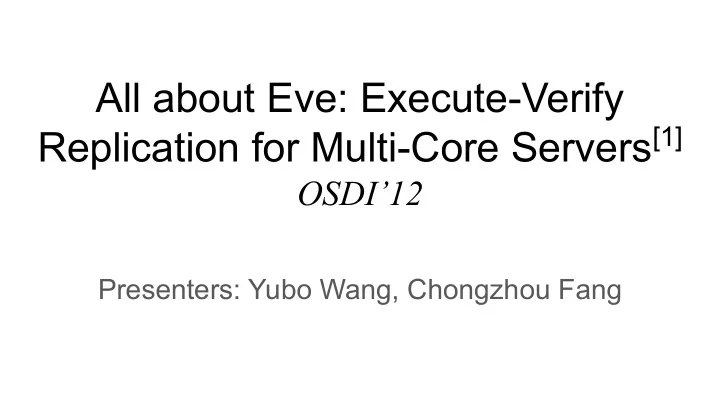

All about Eve: Execute-Verify Replication for Multi-Core Servers [1] OSDI’12 Presenters: Yubo Wang, Chongzhou Fang
Outline 1. Introduction 2. Protocol overview 3. Execution stage 4. Verification stage 5. Experiments 6. Conclusion 7. Reference
Introduction 1. execute-then-verify vs. agree-then-execute 2. deterministic execution vs. Nondeterministic interleaving of requests
Protocol Overview Execution stage: 1. Batching 2. Mixing 3. Executing (in parallel) Verification stage: 1. Agreement 2. Commit or rollback
Execution Stage: Mixer Design 1. parallelBatchList 2. readSet 3. writeSet
Execution Stage: Mixer Design An example for mixer: 1. parallelBatchList 2. readSet 3. writeSet
Execution Stage: Stage Management Deterministic Merkle Tree [2]
Verification Stage ● Goal: ○ Check whether tokens produced by execution replicas match ● Method : ○ Verification Protocol ○ Enough tokens match: Success, commit ○ Not enough: Divergence, roll-back
Verification Stage ● Optimization for Read-Only Requests ○ First executed without involving verification stage ○ Enough replies match: ■ Clients receive values ○ Otherwise: ■ Reissued as regular requests
Verification Stage - Asynchronous BFT ● Difference between PBFT and Verification Protocol 1. In PBFT: agree on the output of a single node ■ In Eve: agree on the behavior of execution replicas 2. In PBFT: agree on the inputs to the state machine ■ In Eve: agree on the outputs of the state machine
Verification Stage - Asynchronous BFT ● Verification process ● E1 E2 V1 V2 V3 V4 pre-prepare prepare commit response
Verification Stage - Asynchronous BFT ● Upon receiving Verify-Response message 1. Commit ■ Condition: View number not increased, agreed-upon token matches previously sent one ■ Action: Mark sequence number stable, release requests to clients, etc.
Verification Stage - Asynchronous BFT ● Upon receiving Verify-Response message 1. Commit ■ Condition: View number not increased, agreed-upon token matches previously sent one ■ Action: Make sequence number stable, release requests to clients, etc. 2. State Transfer ■ Condition: View number not increased, tokens doesn’t match ■ Action: Issues a state-transfer request to other replicas
Verification Stage - Asynchronous BFT ● Upon receiving Verify-Response message 1. Commit ■ Condition: View number not increased, agreed-upon token matches previously sent one ■ Action: Make sequence number stable, release requests to clients, etc. 2. State Transfer ■ Condition: View number not increased, tokens doesn’t match ■ Action: Issues a state-transfer request to other replicas 3. Roll-back ■ Condition: View number increased ■ Action: Roll back state, execute batch sequentially, etc.
Verification Stage - Synchronous Primary-Backup ● System Settings ● Client Primary Backup Match: Release request Unmatch: Roll-back, notify Primary sends batch Backup sends token backup
Verification Stage - Tolerating Concurrency Bugs ● Eve provides protection over concurrency bugs ● Fix concurrency faults: roll-back and sequential execution
Verification Stage - Tolerating Concurrency Bugs ● Asynchronous Case ○ When configured with n exec = 2u+1 and r = 0, asynchronous Eve is safe, live, and correct despite up to u concurrency or omission faults.
Verification Stage - Tolerating Concurrency Bugs ● Asynchronous Case ○ When configured with n exec = 2u+1 and r = 0, asynchronous Eve is safe, live, and correct despite up to u concurrency or omission faults. ● Synchronous Case ○ When configured with just u+1 execution replicas, Eve can continue to operate with 1 replica if u replicas fail by omission
Verification Stage - Tolerating Concurrency Bugs ● Extra protection enter k consecutive EPM during good intervals batches, all n E matches Veirifiers receive minimum number of response to progress EPM: EPM: wait for a short commit timeout Receive all n E Receive all n E EPM: Order roll-back+sequ en-tial exit re-execution
Evaluation 1. Throughput gain 2. Influence of mixer 3. Currency bug mask Key-value store application, H2 Database Engine
Evaluation ● Throughput
Evaluation ● Varying CPU demand
Evaluation ● Varying object size
Evaluation ● Varying conflict probability
Evaluation ● Failure and Recovery
Evaluation ● Concurrency faults
Evaluation ● Comparison with Remus
Conclusion ● Eve ○ New Execute-Verify architecture ○ Allow state machine replication to scale to multi-core servers ○ For the first time: allow interleaving requests nondeterministically and execute independently ○ Tolerate omission/commission faults in both asynchronous and synchronous ○ Protects against concurrency bugs
Reference: [1] Kapritsos, Manos, et al. "All about Eve: execute-verify replication for multi-core servers." Presented as part of the 10th {USENIX} Symposium on Operating Systems Design and Implementation ({OSDI} 12). 2012. [2] Becker, Georg. "Merkle signature schemes, merkle trees and their cryptanalysis." Ruhr-University Bochum, Tech. Rep (2008).
Recommend
More recommend